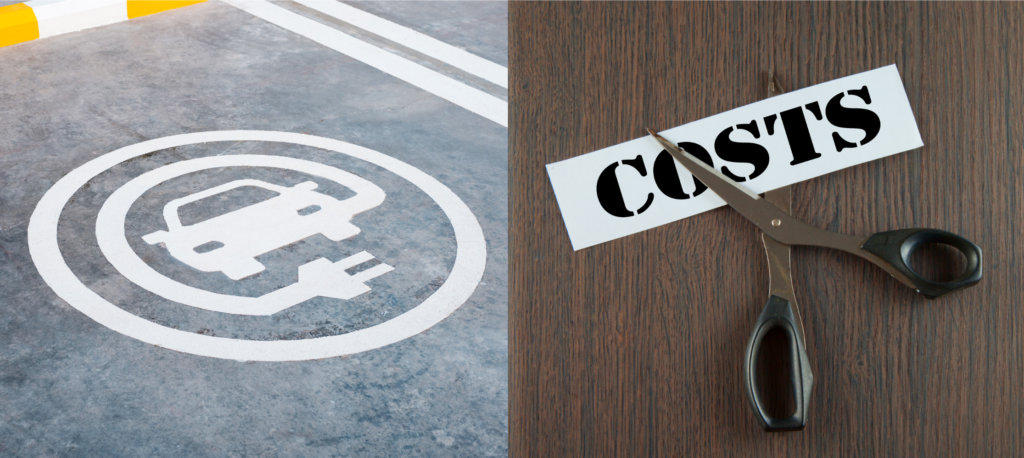The news is filled with stories about electric vehicles (EVs), and we are encouraged to switch from conventional (ICE or internal combustion engine) to electric vehicles. Is fleet electrification right for your company? The answer for many companies is yes—the reason: green and green.
Minimize Carbon Use
Many individuals and companies are focused on minimizing their carbon footprint. Carbon dioxide (CO2), a greenhouse gas (GHG), plays a role in retaining heat in the atmosphere, thereby increasing the temperature on Earth and altering weather patterns.
The transportation sector is the largest emitter of GHG emissions, at 1.9 billion tons of CO2 annually. This fact is impelling fleet operators of large companies to electrify their fleets. One study found that 83 percent of fleet operators pointed to environmental benefits as the primary reason behind their desire to utilize EVs.

By electrifying its fleet, a company eliminates its use of CO2. If fleet electrification were widespread, the reduction in GHG emissions would be significant. A recent report found that “…electrifying all cost-competitive vehicles in 2025 would result in 3.2 million metric tons of GHG emissions reductions over the life of the EVs.” The number would rise to 7.6 million metric tons of GHG emission reductions by 2030.
Scientists cannot say with certainty how this would impact the environment. However, a reduction in emissions of GHG due to fleet electrification would reduce those gasses that are contributing to the changes in the Earth’s temperature.
Other environmental benefits from fleet electrification relate to sustainability. Recent regulatory requirements encourage fleet managers to transition to EVs as they help companies realize their sustainability goals.

Noise pollution is also lessened by switching to EVs. Studies show that noise pollution has serious negative implications, including stress-related illnesses and high blood pressure. EVs are quiet since, unlike traditional vehicles, they do not have mechanical valves, gears, or fans that generate noise. The reduction of noise positively impacts drivers as well as those around the vehicles.
Economic Benefit
New EVs cost more than traditional gas-powered cars; their expense is one of the biggest obstacles to fleet electrification. However, with the great interest in EVs, companies are increasing production.
Basic economics indicates that more companies will enter the market, and current companies will surge production to meet the demand. This scenario should reduce the price differential between EVs and standard cars. Companies may also qualify for tax credits when purchasing EVs, making their prices even more competitive.
It’s post-purchase when fleet operators see savings from the change-over. While the amount of savings will vary depending on the size of the fleet, early adopters have seen up to 25 percent cost savings due to the greater efficiency, lower fuel costs, and less need for maintenance, which are trademarks of EVs, according to this report.

Even better savings were found in a Consumer Reports analysis that compared maintenance and repair costs of EVs and standard vehicles. They found that EVs cost 50 percent less to maintain and repair throughout a vehicle lifespan of 200,000 miles.
Among the reason for the reduction in costs, according to Consumer Reports, is the motors in EVs “…and other drivetrain components have fewer moving parts than internal combustion engines, and they don’t require fluid changes.”
Besides companies saving money over the long haul by fleet electrification, they also gain greater price certainty. Electricity prices tend to be more stable, enabling fleet operators to budget more accurately. Gas prices can swing wildly, thereby impacting fleet operation budgets.
The Road to Fleet Electrification
With fleet operators interested in increasing sustainability, going green, and making more green, why haven’t more electrified their fleets? Change, in general, can be difficult. And the shift to fleet electrification is particularly formidable due to all the obstacles.
One challenge in the switch to electrification involves the charging infrastructure. Knowing which chargers and charging stations are most suitable for your company’s needs and how many chargers are needed per vehicle requires a deep understanding of the infrastructure, your goals, and your fleet.
What about the transition to EVs? Does it need to be an entire fleet at once, or is it wiser to transition as the need arises for a new vehicle? What’s the best strategy?

Your company’s budget may not allow the implementation of the best strategy for electrification. However, many federal, state, and local governments and utility companies provide funding and financing for EVs and charging infrastructure. How can you keep upfront costs to a minimum? What determines the number of rebates and incentives a company qualifies for?
These complex questions, which have no simple answers, can mean the difference between a successful and troubling transition or even a company deciding not to transition.
At Miller Electric, we can answer all your questions about fleet electrification, design, engineering, and charging infrastructure. Our turnkey approach has helped commercial and public entities of all sizes and types, including mass transit authorities, retail spaces, universities, and Fortune 500 companies. Miller Electric can be your sole provider for handling all your EV solutions.
Go Electric
Despite the challenges in transitioning a fleet to EVs, the journey is worth it. Fleet operators can do their part regarding sustainability and other green goals and help their company’s bottom line.
Turn to Miller Electric to simplify the journey of transitioning your fleet to electrification.


